Photos of North American bees
 Bashny.Net
Bashny.Net
The researchers used the latest technology create pictures, developed by the US Army to create beautiful portraits of North American bees.
Photographing Sam Droga, USGS
1. Beautiful bee

Bees are the workhorses in the insect world. Transferring pollen from one plant to another, they provide the next generation of fruits, nuts, vegetables and wildflowers that we love so much.
There are 4,000 species of North American bees living to the north of Mexico, says Sam Drog, head of the program and registry monitoring bees US Geological Survey (USGS).
Only 40 of them - introduced species, including the European honeybee. Most species are overlooked because "many of them are super tiny, says Drogo. "The bulk of the bees in the region about half the size of an ordinary bee».
Local species also go unnoticed because they do not sting, he adds. They quietly engaged in their business - collecting pollen from flowers in the gardens, near the sand dunes, or around the edges of parks
Bee in the photo above is a type of bee carpenter from the Dominican Republic, known as Xylocopa mordax. It nests in the forest or on the stems of yucca, and is closely related to species inhabiting the United States, who build their burrows in dead wood.
2. The coated gold pollen
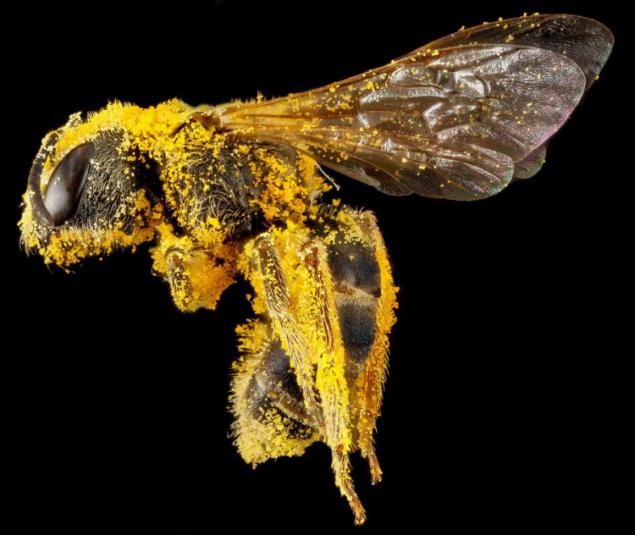
Hearse and his colleagues began to keep a register of all bee species in North America in 2001. This was done due to the fact that these insects are very important to the agricultural industry.
"Almost all the fruits and nuts, and many varieties of vegetables that we eat, require some insects, usually bees for pollination," he explains.
Bee-galikt (Halictus ligatus) pictured above pollinating sunflowers and black-eyed Susan, said Drogo. "This is almost certainly yellow pollen of sunflower pollen.»
3. The head honeybee
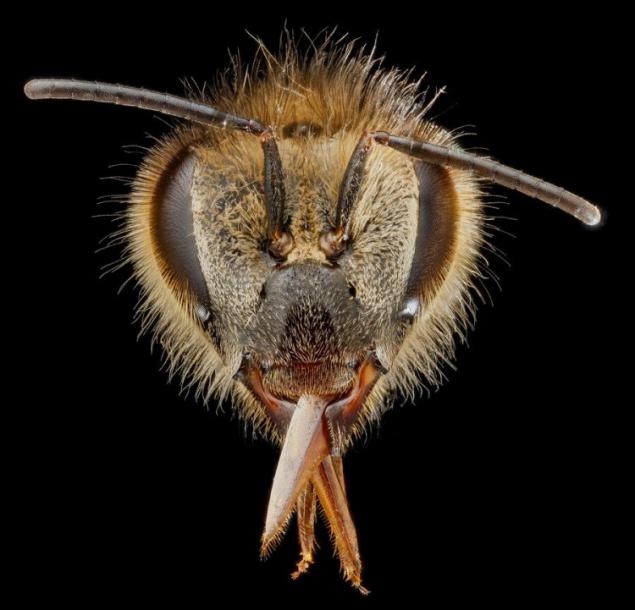
Rather than gather a collection of dried identified bees - that not all would be able to travel and explore - Drog decided to do otherwise: He started a photo catalog of species of bees.
This was before the Drog could learn to make detailed photos, such as photo head honeybee (Apis mellifera), which you see on the photo.
He spent the years, "making such good photos," he says, in an attempt to generate identifiers. But wildlife biologist knew that it was necessary to create a better system.
4. Brilliant Blue
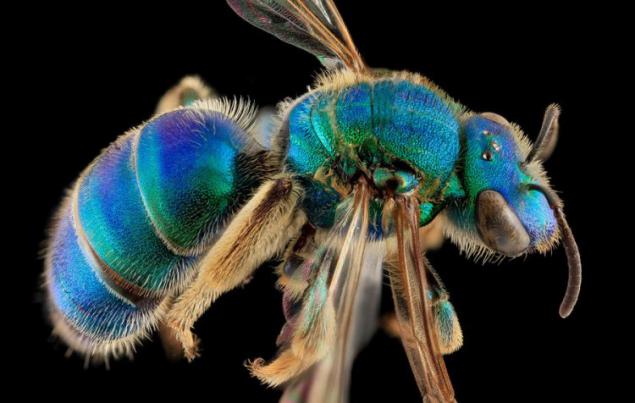
Four years ago, Gutierrez came up with a system that consisted of a fixed camera with a macro lens mount with the slider, and digital software, suitable for connecting your pictures together.
Taking Pictures at an increased level necessary for bees or mosquitoes, meant that there would be absolutely no depth of field, says Drogo. Only parts of the insect would have in the center at any time.
Thus, if researchers or staff of the army wanted a photo of an insect, which would be fully at the center, they had to make a few shots - each of which had to be focused at different points on the sample, and combine photos to a single image in the center. < br />
5. Tab straws
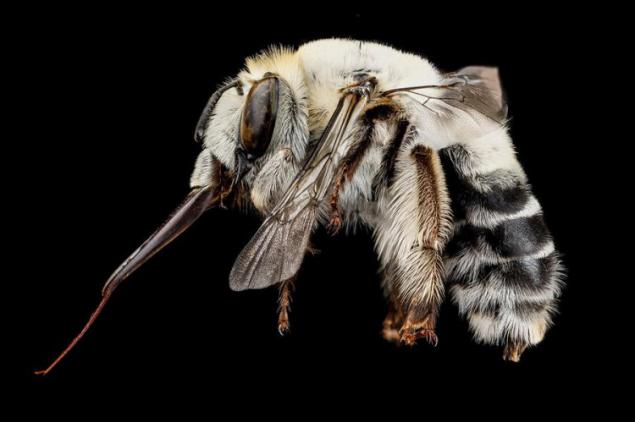
This species, known as Anthophora affabilis, inhabits the Badlands National Park in South Dakota. Her tongue stuck to the left, is a drinking straw in conjunction with the language, says Drogo. "It's two in one».
Bee uses it to get into the funnel-shaped flowers to extract nectar, which lies at the bottom, he explains.
Bee can suck the nectar through "straw" while tiny hairs along the tongue helps to get the remaining grains and droplets of nectar and pollen.
6. Bumblebee
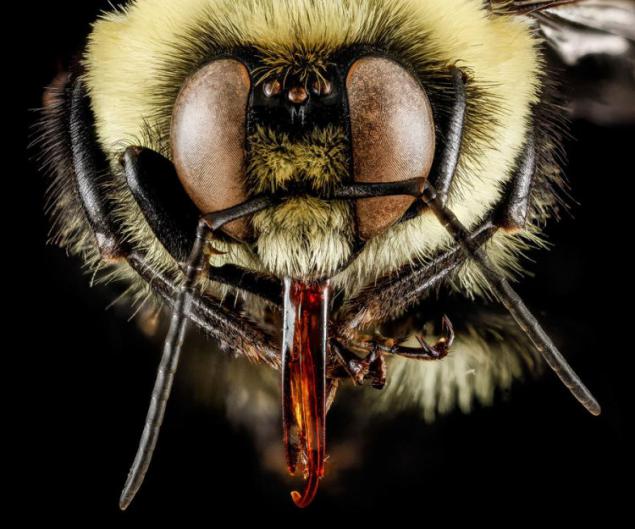
Drog learned over the years to select objects of his photographs - such as this is very common bumblebee (Bombus griseocollis) - with caution.
"Initially, I could grab the lens of any instance that would fall under the arm," he says. " [But] almost all the bees have a lot of lint on the body, "and many of them do not look very good for creating this kind of photography.
Hearse and colleagues dried and prepared specimens of bees as possible better, they can, and use Photoshop after to remove the image from any large specks of dust on them there.
7. Precious melodies
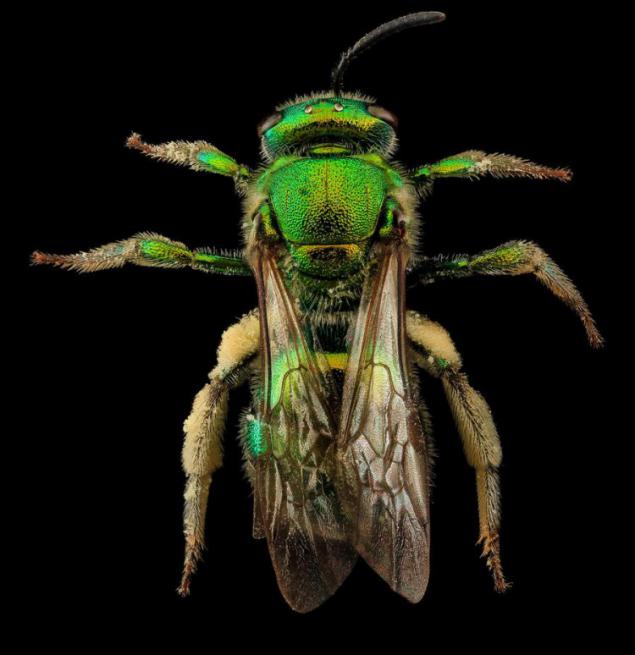
Drog adds that he does not manipulate the colors of their images. "From a scientific point of view is not the case».
"Each bee color," he says. "[And] many of them, of course, the rainbow.»
This bee, known as Augochloropsis Metallica, is one such example. Related to A. sumptuosa, that inhabit the sand dunes, A. Metallica is more generalized finding.
8. Tiny headshot
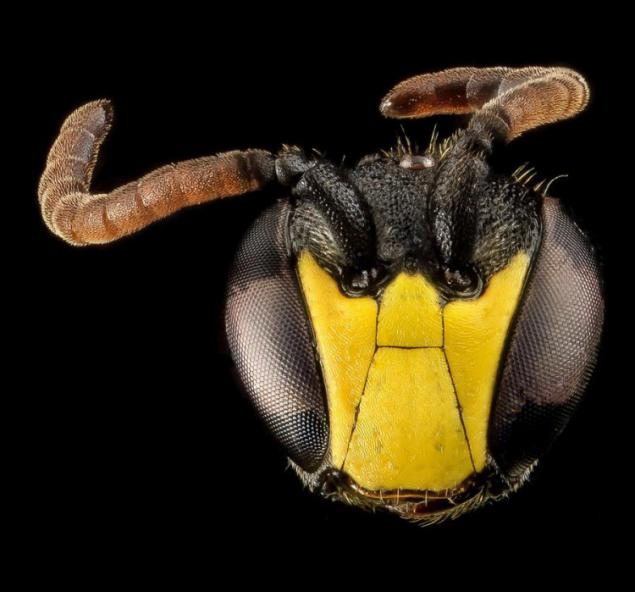
This species, Hylaeus modestus, caught near Washington, DC, about the size of a grain of rice in half. The head is so small that Drogo had to use a needle for acupuncture to set it to take pictures.
"Unlike other bees instead carry pollen on the outer side [her body], they ingest it and carry it internally" explains biologist. In the nest, they regurgitate it, ensuring their eggs food.
Since bees photos were originally intended for a scientific audience, Drog and colleagues are doing shots like this one, for a more detailed examination of certain parts of the body of the insect.
Photographing Sam Droga, USGS
1. Beautiful bee

Bees are the workhorses in the insect world. Transferring pollen from one plant to another, they provide the next generation of fruits, nuts, vegetables and wildflowers that we love so much.
There are 4,000 species of North American bees living to the north of Mexico, says Sam Drog, head of the program and registry monitoring bees US Geological Survey (USGS).
Only 40 of them - introduced species, including the European honeybee. Most species are overlooked because "many of them are super tiny, says Drogo. "The bulk of the bees in the region about half the size of an ordinary bee».
Local species also go unnoticed because they do not sting, he adds. They quietly engaged in their business - collecting pollen from flowers in the gardens, near the sand dunes, or around the edges of parks
Bee in the photo above is a type of bee carpenter from the Dominican Republic, known as Xylocopa mordax. It nests in the forest or on the stems of yucca, and is closely related to species inhabiting the United States, who build their burrows in dead wood.
2. The coated gold pollen

Hearse and his colleagues began to keep a register of all bee species in North America in 2001. This was done due to the fact that these insects are very important to the agricultural industry.
"Almost all the fruits and nuts, and many varieties of vegetables that we eat, require some insects, usually bees for pollination," he explains.
Bee-galikt (Halictus ligatus) pictured above pollinating sunflowers and black-eyed Susan, said Drogo. "This is almost certainly yellow pollen of sunflower pollen.»
3. The head honeybee

Rather than gather a collection of dried identified bees - that not all would be able to travel and explore - Drog decided to do otherwise: He started a photo catalog of species of bees.
This was before the Drog could learn to make detailed photos, such as photo head honeybee (Apis mellifera), which you see on the photo.
He spent the years, "making such good photos," he says, in an attempt to generate identifiers. But wildlife biologist knew that it was necessary to create a better system.
4. Brilliant Blue

Four years ago, Gutierrez came up with a system that consisted of a fixed camera with a macro lens mount with the slider, and digital software, suitable for connecting your pictures together.
Taking Pictures at an increased level necessary for bees or mosquitoes, meant that there would be absolutely no depth of field, says Drogo. Only parts of the insect would have in the center at any time.
Thus, if researchers or staff of the army wanted a photo of an insect, which would be fully at the center, they had to make a few shots - each of which had to be focused at different points on the sample, and combine photos to a single image in the center. < br />
5. Tab straws

This species, known as Anthophora affabilis, inhabits the Badlands National Park in South Dakota. Her tongue stuck to the left, is a drinking straw in conjunction with the language, says Drogo. "It's two in one».
Bee uses it to get into the funnel-shaped flowers to extract nectar, which lies at the bottom, he explains.
Bee can suck the nectar through "straw" while tiny hairs along the tongue helps to get the remaining grains and droplets of nectar and pollen.
6. Bumblebee

Drog learned over the years to select objects of his photographs - such as this is very common bumblebee (Bombus griseocollis) - with caution.
"Initially, I could grab the lens of any instance that would fall under the arm," he says. " [But] almost all the bees have a lot of lint on the body, "and many of them do not look very good for creating this kind of photography.
Hearse and colleagues dried and prepared specimens of bees as possible better, they can, and use Photoshop after to remove the image from any large specks of dust on them there.
7. Precious melodies

Drog adds that he does not manipulate the colors of their images. "From a scientific point of view is not the case».
"Each bee color," he says. "[And] many of them, of course, the rainbow.»
This bee, known as Augochloropsis Metallica, is one such example. Related to A. sumptuosa, that inhabit the sand dunes, A. Metallica is more generalized finding.
8. Tiny headshot

This species, Hylaeus modestus, caught near Washington, DC, about the size of a grain of rice in half. The head is so small that Drogo had to use a needle for acupuncture to set it to take pictures.
"Unlike other bees instead carry pollen on the outer side [her body], they ingest it and carry it internally" explains biologist. In the nest, they regurgitate it, ensuring their eggs food.
Since bees photos were originally intended for a scientific audience, Drog and colleagues are doing shots like this one, for a more detailed examination of certain parts of the body of the insect.
Tags
See also
Works Annie Leibovitz
Selection of funny pictures (72 photos)
Funny pictures and photos with the kids
Stunning landscape photography
A series of photographs "Surreal fashion."
How things work: the airport staff
Hypotheses about the extinction of the dinosaurs
Expression of human emotions animals
Winter Moscow 1959
The nature of the Wild West a century and a half ago
















